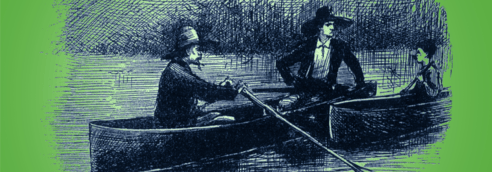Give students the following essay prompts. Ask students to choose a prompt and write their complete essay on a physical or digital document, using evidence from The Adventures of Huckleberry Finn.
*Note: This writing assignment will help you be able to assess how well students are able to synthesize their thoughts and practice both cognitive empathy and critical analysis of the reading.
Essay Prompt 1:
Analyze how Mark Twain’s use of language in The Adventures of Huckleberry Finn shapes the reader’s understanding of the novel’s key characters. In your response, consider how specific textual details show realism (or the “beauty” of American literature) and show the “expression of America in art. As you write, keep in mind William Dean Howells’s statement: “Such beauty and such grandeur as we [American authors] have is common beauty, common grandeur, or the beauty and grandeur in which the quality of solidarity so prevails that neither distinguishes itself to the disadvantage of anything else. It seems to me that these conditions invite the artist to the study and the appreciation of the common.”
Essay Prompt 2:
In the context of the final chapters of The Adventures of Huckleberry Finn, discuss how Twain employs situational irony to comment on the concept of liberty—particularly distinguishing between liberty as the “freedom to act in a way that promotes virtue” and liberty as “the freedom to do whatever one wants regardless of morality or religion.” How does this irony challenge the reader’s understanding of liberty and/or mirror the Founding Fathers’ ideas of liberty as presented in the Declaration of Independence?
Essay Prompt 3:
Analyze how Huckleberry Finn both challenges and reinforces the social expectations of its time. Consider how Twain critiques some aspects of 1840s society while potentially
overlooking others. How might readers from different backgrounds respond to Twain’s social critique? What perspectives are present and which ones seem to be missing from his vision of American democracy?
Instructions
- Choose specific passages from the book that support your thoughts.
- Analyze the ways that the language and the fictional situations reveal deeper truths about democracy or liberty.
- Discuss how Twain uses character development (or lack thereof) to explore important ideas about democracy and liberty.
Considerations
- How do the situations and characters you chose reflect the historical difficulties of equally and universally applying the principles of the Declaration to everyone?
- How do Twain’s language and use of irony challenge or confirm your understanding of equality and liberty as presented in the text?
- How do the conflicts in the story illuminate larger themes of authenticity versus performance, the tension between romanticism and realism, and the need for art to be more democratic?
- How do multiple perspectives and ideas about “American beauty,” “democratic art,” and “liberty” enrich our understanding of these terms in differing times and places?

